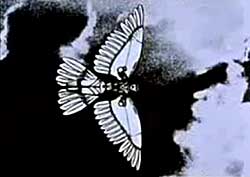 This is a still from Jan Lenica's animation, 'Labyrinth' and a link to watch the video. I find his work completely captivating. The way he uses collage, drawing and moving image to build up utterly surreal worlds and characters is so skilful that this work transcends the label of a cartoon and exists as a piece of fascinating, beautiful and complete artwork in its own right. Animation is such an exciting tool for elevating a drawing and exploring its potential meanings and emotional impact. The soundtrack in this piece adds to and enforces the atmosphere of unease and heightens the feeling of tension, which is particularly apparent when you understand the context in which the film was made. This Kafka-esque, politically charged animation was made in the wake of De-Stalinisation in Poland, with artists finding a new freedom of expression which had been denied to them by Communist censorship, and with an influx of state-sponsored art under the new government, people could now discuss experiences of hardship and oppression. And I suppose through collage and drawing as opposed to a live action film, the artist is free to be imaginative and expressive with use of metaphor, without the constraints of contemporary technologies. I think that films like this have far more charm, aesthetic value and feeling of authorship than modern cartoons made using CGI.
This is a still from Jan Lenica's animation, 'Labyrinth' and a link to watch the video. I find his work completely captivating. The way he uses collage, drawing and moving image to build up utterly surreal worlds and characters is so skilful that this work transcends the label of a cartoon and exists as a piece of fascinating, beautiful and complete artwork in its own right. Animation is such an exciting tool for elevating a drawing and exploring its potential meanings and emotional impact. The soundtrack in this piece adds to and enforces the atmosphere of unease and heightens the feeling of tension, which is particularly apparent when you understand the context in which the film was made. This Kafka-esque, politically charged animation was made in the wake of De-Stalinisation in Poland, with artists finding a new freedom of expression which had been denied to them by Communist censorship, and with an influx of state-sponsored art under the new government, people could now discuss experiences of hardship and oppression. And I suppose through collage and drawing as opposed to a live action film, the artist is free to be imaginative and expressive with use of metaphor, without the constraints of contemporary technologies. I think that films like this have far more charm, aesthetic value and feeling of authorship than modern cartoons made using CGI.http://www.youtube.com/watch?v=Zdq38KPMCvY
 Shaun Tan's "The Rabbits"
Shaun Tan's "The Rabbits" 